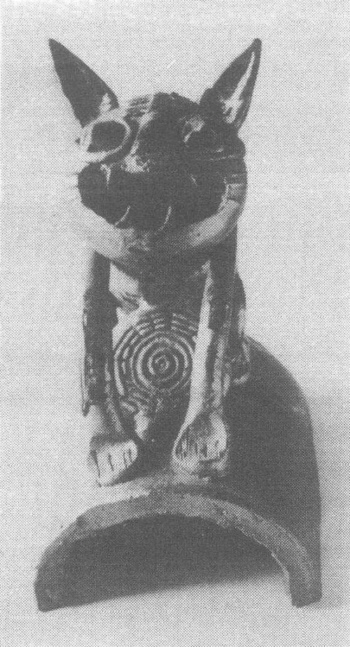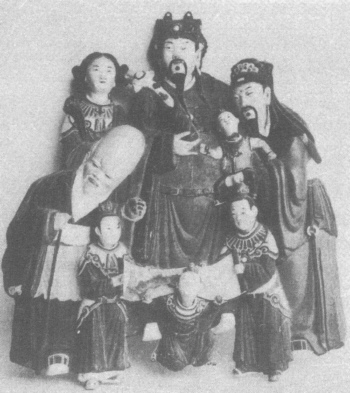Chapter 19 Section 2
Repelling evil spirits and seeking good luck can be said to be the oldest theme in folk sculpture.Needless to say, the primitive society, after entering the civilized society, such themes appear one after another.In terms of the works that directly affect today, the number is astonishing.
Generally speaking, evil spirit works are related to gods or gods and monsters.The reason is very simple, what can cause harm or misfortune to people is often an unfathomable or irresistible force.To avoid or stop these forces that cause disasters to humans, human beings can only resort to inhuman forces, namely the power of gods or gods and monsters.In folk sculptures, some common images of evil spirits often come from ancient myths and legends, or are born out of some stories or rumors about supernatural beings, such as Pushou Tunkou, Zhong Kui [kui Kui] and so on.The basic image of Pushou Tunkou is either a dragon or a tiger, or a combination of humans and animals. Its origins include not only the prototype of Fang Xiangshi (the image is a bear skin and four golden eyes) who exorcised ghosts and exorcisms in ancient times, but also the one commonly used in Shang and Zhou bronze wares. The Taotie that expresses divine power, the prototype of Kuilong, and the tiger that eats evil spirits on Dushuo Mountain recorded in the book, and the images of gods and spirits of various ethnic groups in various places that suppress evil and avoid harm are added at any time during the production.Therefore, the shapes of the shop's first swallowing mouth are various and extremely vivid.Zhong Kui, formerly known as Zhong Kui, is a stick-shaped object with the function of expelling evil spirits in the Han Dynasty. In the Tang Dynasty, it evolved into a scholar named Zhong Kui. The great god who subdues demons.The story of Zhong Kui represents the common people's aversion to the evildoers of the powerful and evildoers and their desire for justice and peace. Although Zhong Kui's artistic image is ugly, he is still widely welcomed and has penetrated into thousands of households.Sculptures for exorcising evil spirits are generally more ferocious in shape, and their production techniques are more exaggerated, with a mouth full of divine power.Not to mention Zhong Kui, even if it is a common object in life, once it is endowed with the function of warding off evil spirits, its image must follow this creative principle.For example, the tile cats in Yunnan are all molded into angry shapes with wide eyes and steel teeth, not the slightest appearance of pet cats. (Figure 30)

Figure 30 Modern Yunnan with tiles, cats and tiles (collected by Yunnan Qunyi Museum)
The motivation for creating good-looking sculptures in primitive society may be simply to avoid disasters and survive.But after entering the class society, people's values have changed, and in addition to the original motivation, many new requirements have been added.These requirements are most typically and most concentratedly reflected in the pursuit of the five aspects of blessing, salary, longevity, happiness, and wealth.Fu refers to good luck and blessings (including many children and grandchildren); salary refers to official luck, fame and wealth;For the expression of these contents, there are combined forms such as Fu Lu Shou Samsung Gaozhao, Lu (Lu) Crane (Longevity) Tongchun, etc.; there are also expressions of a certain content alone, such as Maodie Shoushi, which is a homophonic old man [maodie hat stack] Shou Stones all indicate longevity. (Figure 31) Among these five contents, the items that have been evolved into various forms are blessing, happiness, and wealth.Especially the last two items (happiness and wealth), there are not only all kinds of gods of happiness and wealth, but also a variety of images that express happiness and wealth, such as happy eyebrows (magpies standing on plum trees), surplus every year (children) Holding a lotus flower and sitting on the back of a fish), etc.In short, in the category of exorcising evil and seeking good luck, the content, style, and application places of seeking good luck are far more than those of exorcising evil.This just reflects the realistic mentality of ordinary people who want to gain real benefits.

Figure 31 Fu Lu Shou Hanging Clay Modern Shaanxi Yulin (collection of Shaanxi Qunyi Museum)

Figure 30 Modern Yunnan with tiles, cats and tiles (collected by Yunnan Qunyi Museum)

Figure 31 Fu Lu Shou Hanging Clay Modern Shaanxi Yulin (collection of Shaanxi Qunyi Museum)
